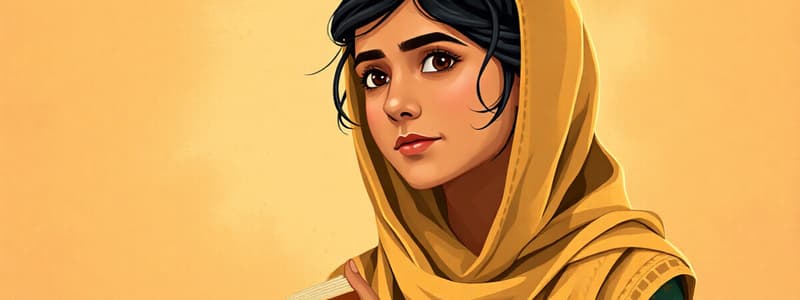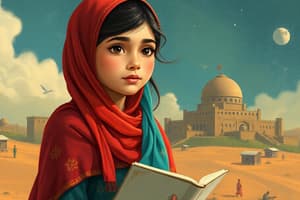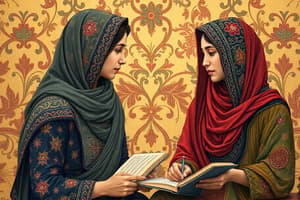Podcast
Questions and Answers
What was the narrator's favorite thing about the school?
What was the narrator's favorite thing about the school?
- The lessons in his own baby talk (correct)
- The clean, modern classrooms
- The beautiful uniform
- The smell of the river
What can be inferred about the narrator's family's financial situation from the text?
What can be inferred about the narrator's family's financial situation from the text?
- The narrator's family was able to provide well for themselves even while running their school.
- The narrator's family was wealthy and could afford to provide a comfortable life for themselves.
- The narrator's family was struggling financially, but they were determined to have a school for the community. (correct)
- The narrator's family had a steady income from the school but their expenses were too high.
What is the purpose of the author's description of the school's facilities and the narrator's father's roles in the school?
What is the purpose of the author's description of the school's facilities and the narrator's father's roles in the school?
- To emphasize the financial prosperity of the school and the family.
- To highlight the modern and well-equipped facilities of the school.
- To show the dedication and sacrifice of the narrator's father and the sense of community in the school. (correct)
- To criticize the lack of proper resources and the poor conditions of education.
What is the significance of the narrator's longing to wear shalwar kamiz?
What is the significance of the narrator's longing to wear shalwar kamiz?
What is the main theme of the passage?
What is the main theme of the passage?
What does Malala express a dislike for in the passage?
What does Malala express a dislike for in the passage?
Which of the following statements describes Malala's view on makeup and jewelry?
Which of the following statements describes Malala's view on makeup and jewelry?
What does Malala believe about boys' backpacks and uniforms?
What does Malala believe about boys' backpacks and uniforms?
What influenced Malala's choice of her name?
What influenced Malala's choice of her name?
How does Malala react to her brothers fighting with her?
How does Malala react to her brothers fighting with her?
What does Malala express in her conversation with God regarding her brothers?
What does Malala express in her conversation with God regarding her brothers?
In which location was Malala born?
In which location was Malala born?
What activity does Malala mention she enjoyed when she was younger?
What activity does Malala mention she enjoyed when she was younger?
What lesson did Malala's father emphasize when comforting her?
What lesson did Malala's father emphasize when comforting her?
What does the tradition of badala refer to in Pashtunwali culture?
What does the tradition of badala refer to in Pashtunwali culture?
What was Malala's reaction after her incident with Safina?
What was Malala's reaction after her incident with Safina?
What describes the sense of community in Malala's household?
What describes the sense of community in Malala's household?
What feeling did Malala experience while waiting for her father to return home?
What feeling did Malala experience while waiting for her father to return home?
What does the saying from Malala's father's story imply about childhood?
What does the saying from Malala's father's story imply about childhood?
What game did Malala and other children play in the grassy lot behind her house?
What game did Malala and other children play in the grassy lot behind her house?
What does the overall Pashtunwali code prioritize?
What does the overall Pashtunwali code prioritize?
What sentiment did the relatives express towards the speaker's boldness?
What sentiment did the relatives express towards the speaker's boldness?
What was one associated expectation for girls as they grew older?
What was one associated expectation for girls as they grew older?
In what way did the father differ from societal customs regarding the birth of children?
In what way did the father differ from societal customs regarding the birth of children?
What did the speaker reflect upon while watching her brothers launch their kites?
What did the speaker reflect upon while watching her brothers launch their kites?
How did her father's view on education for girls reflect in her upbringing?
How did her father's view on education for girls reflect in her upbringing?
What does the song about Malalai signify to the speaker?
What does the song about Malalai signify to the speaker?
What role did the father play in the speaker's education?
What role did the father play in the speaker's education?
What was the significance of the speaker's name being included in the family tree?
What was the significance of the speaker's name being included in the family tree?
What does the author suggest is the most captivating aspect of the women's world?
What does the author suggest is the most captivating aspect of the women's world?
What is the most significant contrast the author highlights between the men's and women's spaces within the home?
What is the most significant contrast the author highlights between the men's and women's spaces within the home?
Which of the following is NOT mentioned as a practice associated with purdah?
Which of the following is NOT mentioned as a practice associated with purdah?
How does the author's perspective on the practice of purdah evolve from childhood to adolescence?
How does the author's perspective on the practice of purdah evolve from childhood to adolescence?
What does the author's statement "My face was my identity" reveal about his values?
What does the author's statement "My face was my identity" reveal about his values?
What is the main purpose of this passage?
What is the main purpose of this passage?
Based on the passage, which statement BEST reflects the author's attitude towards the men's world?
Based on the passage, which statement BEST reflects the author's attitude towards the men's world?
What does the author's description of the women's headscarves and veils being "gone" and their faces being "radiant with freedom" suggest?
What does the author's description of the women's headscarves and veils being "gone" and their faces being "radiant with freedom" suggest?
What is the most likely reason the narrator no longer plays cricket with their brothers?
What is the most likely reason the narrator no longer plays cricket with their brothers?
What is the significance of the phrase "two taps" in the passage?
What is the significance of the phrase "two taps" in the passage?
Based on the passage, which of the following is a characteristic of Safina?
Based on the passage, which of the following is a characteristic of Safina?
Which of the following is NOT a game played by the narrator and their brothers?
Which of the following is NOT a game played by the narrator and their brothers?
What can be inferred about the narrator's relationship with their brothers as they grow older?
What can be inferred about the narrator's relationship with their brothers as they grow older?
The passage states that the brothers "played cricket day and night in the alley by our house or up on our roof, which was flat." What does this detail reveal about the brothers' relationship?
The passage states that the brothers "played cricket day and night in the alley by our house or up on our roof, which was flat." What does this detail reveal about the brothers' relationship?
The narrator states that "boys are, well, boys. Most of them are not as civilized as girls." What is the author likely trying to convey with this statement?
The narrator states that "boys are, well, boys. Most of them are not as civilized as girls." What is the author likely trying to convey with this statement?
The narrator describes their mother as "so upset she wouldn't look at me." What is the most likely reason for the mother's upset?
The narrator describes their mother as "so upset she wouldn't look at me." What is the most likely reason for the mother's upset?
Flashcards
What is Malala's ethnicity?
What is Malala's ethnicity?
Malala Yousafzai is a Pashtun, a member of a large tribe found in both Afghanistan and Pakistan.
Where was Malala born?
Where was Malala born?
Malala was born in Mingora, the biggest city of the Swat Valley, a region known for its stunning natural beauty in northwest Pakistan.
Who is Malala named after?
Who is Malala named after?
Malala's name is a tribute to Malalai, a courageous Pashtun woman who inspired her people with her bravery.
Where did Malala's family originate from?
Where did Malala's family originate from?
Signup and view all the flashcards
Who is Malala's older brother?
Who is Malala's older brother?
Signup and view all the flashcards
What is Malala's favorite way to annoy people?
What is Malala's favorite way to annoy people?
Signup and view all the flashcards
Who is Malala's younger brother?
Who is Malala's younger brother?
Signup and view all the flashcards
What are some of Malala's personal opinions and observations?
What are some of Malala's personal opinions and observations?
Signup and view all the flashcards
Chasing Game
Chasing Game
Signup and view all the flashcards
Cricket
Cricket
Signup and view all the flashcards
Chindakh
Chindakh
Signup and view all the flashcards
Thief and Police
Thief and Police
Signup and view all the flashcards
Shaka Laka Boom Boom
Shaka Laka Boom Boom
Signup and view all the flashcards
Ringing a Bell
Ringing a Bell
Signup and view all the flashcards
Two Taps
Two Taps
Signup and view all the flashcards
Pink Plastic Cell Phone
Pink Plastic Cell Phone
Signup and view all the flashcards
What is Badal?
What is Badal?
Signup and view all the flashcards
What is Hospitality in Pashtunwali?
What is Hospitality in Pashtunwali?
Signup and view all the flashcards
What is the concept of 'giving' in Pashtunwali?
What is the concept of 'giving' in Pashtunwali?
Signup and view all the flashcards
What is the meaning of 'jani'?
What is the meaning of 'jani'?
Signup and view all the flashcards
What is Pashtunwali?
What is Pashtunwali?
Signup and view all the flashcards
What is 'Parpartuni' ?
What is 'Parpartuni' ?
Signup and view all the flashcards
What is a 'stupa'?
What is a 'stupa'?
Signup and view all the flashcards
Who is Mohammad Ali Jinnah?
Who is Mohammad Ali Jinnah?
Signup and view all the flashcards
Purdah
Purdah
Signup and view all the flashcards
Niqab
Niqab
Signup and view all the flashcards
Burqa
Burqa
Signup and view all the flashcards
Social restrictions imposed on women
Social restrictions imposed on women
Signup and view all the flashcards
Pull to the men's world
Pull to the men's world
Signup and view all the flashcards
Women's gatherings without veils
Women's gatherings without veils
Signup and view all the flashcards
Living under wraps
Living under wraps
Signup and view all the flashcards
Face as identity
Face as identity
Signup and view all the flashcards
Gender Inequality in Pakistan
Gender Inequality in Pakistan
Signup and view all the flashcards
Malala's Name on the Family Tree
Malala's Name on the Family Tree
Signup and view all the flashcards
The Song of Malalai
The Song of Malalai
Signup and view all the flashcards
Malala's Father's Support
Malala's Father's Support
Signup and view all the flashcards
Limited Freedoms for Girls
Limited Freedoms for Girls
Signup and view all the flashcards
The Clash of Tradition and Ambition
The Clash of Tradition and Ambition
Signup and view all the flashcards
Malala's Father's School
Malala's Father's School
Signup and view all the flashcards
Dream of Freedom
Dream of Freedom
Signup and view all the flashcards
Malala's Passion for Learning
Malala's Passion for Learning
Signup and view all the flashcards
Malala's Father's Dedication
Malala's Father's Dedication
Signup and view all the flashcards
Family's Commitment to Education
Family's Commitment to Education
Signup and view all the flashcards
School as Malala's World
School as Malala's World
Signup and view all the flashcards
Malala's Excitement for School
Malala's Excitement for School
Signup and view all the flashcards
Study Notes
Malala's Childhood in Swat Valley
- Malala is a girl with special talents, including double-jointedness and arm-wrestling skills.
- She enjoys watching people squirm when she cracks her knuckles.
- She does not like eggplant and green peppers but loves pizza.
- She dislikes dark chocolate and finds Bella from Twilight to be fickle.
- Her favorite color is pink.
Malala's Family and Cultural Background
- Malala is Pashtun, a member of a proud tribe.
- Her family is from mountain villages in Swat Valley, Pakistan.
- Swat Valley is known for its beauty, tall mountains, lush green hills, and clear rivers.
- Malala's father (Ziauddin) and mother (Toor Pekai) relocated to Mingora, the largest city in the Swat Valley.
- Pashtunwali code governs how Pashtuns live. This code includes aspects of hospitality and revenge (badal).
Malala's Siblings and Friends
- Malala has two brothers, Khushal and Atal.
- Malala has a close friend named Safina.
- Her brothers can be annoying. Khushal fights with her, Atal is less annoying and good at playing cricket.
- She and Safina communicate in secret through a hole in the wall.
- They play games like tag, Mango, hopscotch (Chindakh), and Thief and Police.
- They enjoy playing cricket, using improvised materials when needed.
Other Aspects of Malala's Life
- Malala has an interest in playing with dolls and watching TV shows like Shaka Laka Boom Boom.
- She likes to spend time in the mirror playing with her hair.
- She tried to lighten her skin as a child.
- Her family runs a school.
- Her father is the teacher, accountant, principal, janitor, handyman, and chief mechanic.
- The family's financial situation is challenging.
- Cultural practices differ between men and women in the Pashtun community.
- Women wear traditional robes that cover their heads and faces, often called niqab or burqa.
Studying That Suits You
Use AI to generate personalized quizzes and flashcards to suit your learning preferences.




